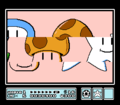Spade Panel: Difference between revisions
mNo edit summary Tag: Mobile edit |
m (→Mechanics) Tag: Mobile edit |
||
| Line 32: | Line 32: | ||
[[File:SMB3 Spade Panel Delay Frames.png|700px]] | [[File:SMB3 Spade Panel Delay Frames.png|700px]] | ||
The delay range for the first reel (16 frames) is three frames fewer than its timing window (19 frames), meaning that for each full revolution of the reels, the player has a window of three frames to press {{button|nes|A}} to guarantee that the reel | The delay range for the first reel (16 frames) is three frames fewer than its timing window (19 frames), meaning that for each full revolution of the reels, the player has a window of three frames to press {{button|nes|A}} to guarantee that the reel will stop on a desired picture, regardless of any added delay. However, the delay ranges for the second and third reels (32 and 64 frames, respectively) are larger than their timing windows (19 and 16 frames, respectively), meaning that the delay can potentially cause the reel to skip over the entire timing window for a certain picture; therefore, it is impossible for the player to guarantee that the second and third reels will stop on a desired picture. For the third reel, the minimum delay of 64 frames is equivalent to one full revolution of the reel, and the maximum delay of 127 frames is equivalent to two full revolutions, essentially meaning that the third reel can start slowing down anywhere on the reel and stop on any of the pictures, regardless of when the player presses {{button|nes|A}}. Thus, the outcome of the minigame cannot be determined by the player whatsoever. | ||
==Gallery== | ==Gallery== | ||
Latest revision as of 11:01, November 15, 2024
| Spade Panel | |
|---|---|
| First appearance | Super Mario Bros. 3 (1988) |
| Latest appearance | Super Mario All-Stars Limited Edition (2010) |
Spade Panels,[1][2] also known as Flip Games[3] or Spade Houses,[4] are small panels on overworld maps in Super Mario Bros. 3 that can be used to earn extra lives for Mario or Luigi. Once the player enters one, they can play a minigame hosted by a Toad. Its gameplay is similar to that of a slot machine, in which parts of pictures slide past on three different reels, and the player must line up three matching parts to make a picture and win extra lives. There are Mushroom, Flower, and Star icons on each reel, granting two, three, and five extra lives when lined up as the Mushroom Picture,[1][2] the Flower Picture,[1][2] and the Star Picture,[1][2] respectively, similarly to the goal at the end of nearly every level. If any of the picture parts are mismatched, no extra lives are awarded. The player gets only one chance to play the minigame, after which the Spade Panel disappears.
In Super Mario Advance 4: Super Mario Bros. 3, if a Spade Panel is matched up correctly, further Spade Panels change to Heart Panels. The Stars are replaced by Super Leaf icons that give seven extra lives. Clearing one of these turns further Heart Panels into Club Panels, and the Super Leaves change to "3" icons that reward 10 extra lives. Clearing a Club Panel turns further panels into Diamond Panels, where only one picture can be lined up, making it impossible to lose. Earning a minimal number of lives at previous panels results in a Mushroom Picture, while higher numbers yield a random picture, and each picture gives the corresponding number of extra lives. If the player clears a Diamond Panel, or fails at any of the other ones, all panels revert to Spade Panels, restarting the process. Clearing all levels makes all Spade Panels reusable.
A special Spade Panel, the N-Mark Spade Panel, appears every 80,000 points. When it is activated, the player plays a card game for prizes, with a total of nine prizes per game. After the game, all prizes earned are included in the player's inventory. Unlike with the other Spade Panel games, a player can make two mistakes during an N-Mark Spade Panel game before being returned to the world map; when the next 80,000 points are achieved, the player can continue the game off where they left.
In Super Mario Maker 2, while the Spade Panel itself does not appear, its minigame reappears in the World Maker mode as Match & Win!, which can be played in one of the Toad Houses the player can place on the world map. Unlike the game it is based on, Match & Win! is deterministic and can be reliably timed by the player.
Mechanics[edit]
During the minigame, when the player presses to stop one of the reels, a random number generator is used to add an arbitrary amount of delay before the reel starts to slow down and stop on a certain picture. The delay times for all reels are randomized during the introductory cutscene, and the delay of the first reel continues to be randomized until the player stops the reel; however, the delays of the second and third reels are fixed when the player leaves the cutscene and the reels start spinning.[5]
The following table shows the minimum and maximum possible delay times for each reel, along with the range between the maximum and minimum delay. The column labeled "Timing window" denotes the number of frames during which a certain picture can be obtained if the reel starts slowing down immediately—i.e., zero delay frames are added.[5]
| Reel | Minimum delay | Maximum delay | Delay range | Timing window |
|---|---|---|---|---|
| First reel | 32 frames | 47 frames | 16 frames | 19 frames |
| Second reel | 32 frames | 63 frames | 32 frames | 19 frames |
| Third reel | 64 frames | 127 frames | 64 frames | 16 frames |
The image below visualizes these values; the delay range is highlighted in blue, and the timing window with zero delay frames is highlighted in red.
The delay range for the first reel (16 frames) is three frames fewer than its timing window (19 frames), meaning that for each full revolution of the reels, the player has a window of three frames to press to guarantee that the reel will stop on a desired picture, regardless of any added delay. However, the delay ranges for the second and third reels (32 and 64 frames, respectively) are larger than their timing windows (19 and 16 frames, respectively), meaning that the delay can potentially cause the reel to skip over the entire timing window for a certain picture; therefore, it is impossible for the player to guarantee that the second and third reels will stop on a desired picture. For the third reel, the minimum delay of 64 frames is equivalent to one full revolution of the reel, and the maximum delay of 127 frames is equivalent to two full revolutions, essentially meaning that the third reel can start slowing down anywhere on the reel and stop on any of the pictures, regardless of when the player presses
. Thus, the outcome of the minigame cannot be determined by the player whatsoever.
Gallery[edit]
Super Mario Bros. 3[edit]
Super Mario All-Stars[edit]
Super Mario Advance 4: Super Mario Bros. 3[edit]
Names in other languages[edit]
| Language | Name | Meaning | Notes |
|---|---|---|---|
| Japanese | スペードパネル[6] Supēdo Paneru |
Spade Panel | |
| French | Panneau Pique[7] | Spade Panel | |
| German | Pik-Feld[8] | Spade Field | |
| Italian | Quadro del segno di picche[9] | Spade symbol square | |
| Pannello picche[10] | Spade panel | ||
| Asso di picche[11] | Ace of Spade | ||
| Spanish | Panel de Picas[12] | Panel of Spades |
Trivia[edit]
- This minigame's theme music is arranged in Super Mario RPG: Legend of the Seven Stars (for Grate Guy's Casino), Super Mario 64 DS, New Super Mario Bros. (both for the minigames Wanted!, Connect the Characters, and Mario's Slides), Paper Mario: Sticker Star, Paper Mario: Color Splash (both for Snifit or Whiffit), Mario Party: Island Tour (for the minigame theme "Slowly Bubble Up"), and Super Mario Odyssey (for the Slots minigame).
- This minigame's theme music in Super Mario Bros. 3 is a looped sample from the bassline (or pause music) from Super Mario Bros. 2's Ground Theme.
- Much like the case with Bowser's wristbands from the original Super Mario Bros., in the sprites for Mario and the Toad in the Spade Panel cutscene, due to the NES supporting just three colors for each sprite, Mario/Luigi's gloves and the white parts of the Toad's body, including the primary color for his mushroom "hat" and pants, are actually transparent and appear white due to the sprites appearing in front of a white background. This also results in the Toad gaining an orange pixel (formed from the brick outlines of the wall) on his sprite if one looks closely enough.
References[edit]
- ^ a b c d 1993. Super Mario All-Stars instruction booklet. Nintendo of America (English). Page 31–32.
- ^ a b c d 1990. Super Mario Bros. 3 instruction booklet. Nintendo of America (English). Page 21.
- ^ Peterson, Erik (2003). Super Mario Advance 4: Super Mario Bros. 3 Player's Guide. Nintendo of America (American English). ISBN 1930206-37-2. Page 18.
- ^ Super Mario Advance 4: Super Mario Bros. 3 Prima's Official Strategy Guide back cover
- ^ a b Retro Game Mechanics Explained (October 7, 2023). SMB3 Roulette & Card Matching Games Explained. YouTube (English). Retrieved December 26, 2023.
- ^ 1988. スーパーマリオブラザーズ3 (Sūpā Mario Burazāzu Surī) instruction booklet. Nintendo (Japanese). Page 19.
- ^ 2003. Super Mario Advance 4: Super Mario Bros. 3 instruction booklet. Nintendo of Europe (French). Page 50.
- ^ 2003. Super Mario Advance 4: Super Mario Bros. 3 instruction booklet. Nintendo of Europe (German). Page 30.
- ^ Super Mario Bros. 3 manual. Nintendo (Italian). Page 16.
- ^ 2010. Super Mario All-Stars 25th Anniversary Edition manual. Nintendo of Europe (Italian). Page 17.
- ^ Super Mario Bros. 3 (3DS - Virtual Console) Italian e-manual. Page 10.
- ^ 2003. Super Mario Advance 4: Super Mario Bros. 3 instruction booklet. Nintendo of Europe (German). Page 90.








